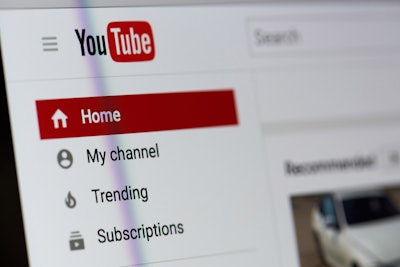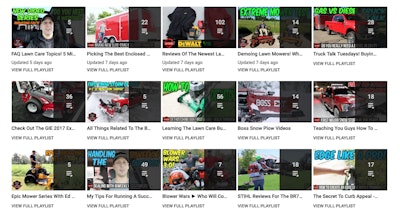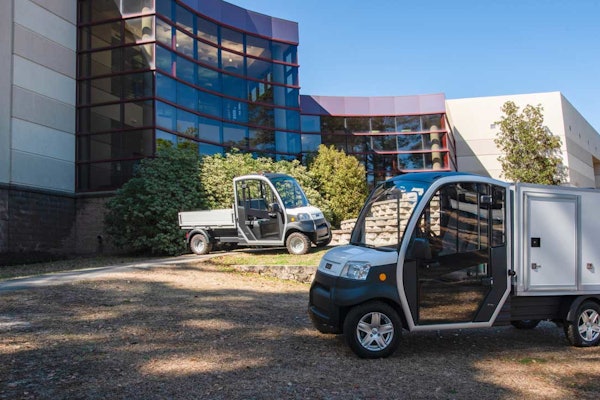
There are numerous YouTube channels related to landscaping and lawn care, with professionals sharing information from proper planting practices to financial advice. As these channels grow in popularity, more are turning to these influencers for their take on certain pieces of equipment and business tips.
Total Landscape Care reached out to Brian Fullerton, owner of Brian’s Lawn Maintenance based in Detroit, Michigan, to learn more about how he got started with his YouTube channel and what advice he has for others who might want to create their own channel.
How it all started
Fullerton started his channel in March 2016. He has been in business for 12 years as a lawn care operator. He says he launched the channel for two reasons. One was to provide equipment reviews on brands that current lawn care YouTubers weren’t covering.
“The other oar in the water was to give back, to pay it forward and document our journey and what we have going on,” Fullerton says. “(We want to) try to steer people clear of mistakes and hopefully help people double down on our successes. We try to give practical advice that folks can use to implement in their own lawn care business.”
Since launching Brian’s Lawn Maintenance on YouTube, Fullerton has grown his channel to over 50,000 subscribers and has had over 7 million views total. His goal is to reach 100,000 subscribers by the end of this year.
“I think there’s a really good chance of getting to that by fall,” he says. “Ultimately, we didn’t start this with any goal in mind. It was a labor of love and it’s just a fun hobby that we’ve taken more seriously as the months have gone by. Getting to a million subscribers with a lawn care channel is a little out there. I think there’s a really good prospect of us hitting 100,000.”
Fullerton says that once you have 1,000 subscribers and 4,000 hours of watched content, you can get paid through YouTube’s ad revenue.
“You can clean up with ads,” he says. “It’s one of those things where your first year you can make $100, your second year you make $1,000 and then literally out of nowhere you can make $2-5,000 a month just from the ads. YouTube’s exponential like a lot of things in life.”
The ins and outs of running a channel
In the beginning, Fullerton says it was more sporadic as to when he would upload a video, but he says now they try to post three times a week. Currently, he says he posts on Mondays, Wednesday and Saturdays, and his truck-related videos are posted on Tuesdays as part of Truck Talk Tuesdays.
“I usually try to break it down into three or four different categories,” he says. “One is usually an equipment review. Another one we try to do is a mindset video where we’re trying to explain some thought process of the business, and then outside of that we try to do truck talk videos and then a fourth one we try to do at least once a week is a vlog showing what’s going on with our week.”
As to why his channel has become so popular, Fullerton believes it’s because he is relatable to most owner operators who have a similar setup of having a mower or two, an employee or two and makes between $50,000 and $150,000 in revenue. He also jokes that he’s easy on the eyes.
“We know how to communicate and make it relatable and understandable in five to 10 minutes,” he says. “You can get some good content out of it and it’s not boring. I think we’re decently entertaining. I think we also like to have fun.”
The most popular videos on Fullerton’s channels, without a doubt, are his equipment comparison videos, with certain ones like his Blower Wars 3.0 raking in more than 147,000 views. His 4-way battery chainsaw video was another attention getter with more than 73,000 views.
“I think folks like knowing the pros and cons of different brands that are out there and we can also do that while comparing them to other pieces of equipment, so if we do a blower wars comparison video or a lawn mower comparison video, folks really seem to like comparing when they’re shopping for equipment,” he says.
When it comes to the length of the videos, Fullerton says his average video is anywhere between seven to 15 minutes. He prefers not to stress about the runtime, letting the video just be as long as it needs to be.
While part of YouTube algorithm does take note of a video’s length, catering solely to the algorithm shouldn’t be your goal.
Fullerton says YouTube is still a lottery and getting a viral video comes down to luck. He focuses on making content that engages people.
“You’ve got to make content people want to watch and if people want to watch it and engage with it, then the algorithm recognizes that and it says, ‘Hey, maybe more people want to watch this video.’”
He says click bait titles and thumbnails are only a short-term win for views, but long term you’ll lose trust with your followers.
“You’ll never see me do any of that ever,” Fullerton says. “Although, some people, including lawn care (channels), make a career out of that with drama, complaining and whining. That’s fine short term but long term, nobody wants to deal with that sort of person and neither does any brand.”
Speaking of brands, Fullerton says at first, he was the one reaching out brands and requesting products to review, but now in the past six to nine months, the tables have turned completely.
“Pretty much everyone and their brother wants to send us something now to review and even more so in the last three months, and going into the years forward, people send us stuff and also want to do sponsored videos,” he says.
Creating a channel yourself
The recent boom in lawn care-related YouTube channels may seem a little behind the times to outsiders, but Fullerton says this is just because the green industry is one of the last to tackle social media.
“I think our industry is five to 10 years behind the eight ball when it comes to a lot of this stuff,” Fullerton says. “Guys like myself are leading the charge. We’re pioneering the industry and we’re growing a community, and we’re attracting those ad dollars and convincing these companies that it’s a good idea.”
If you are looking to create a YouTube channel for your company, the first two things you have to do are decide what audience you’re wanting to serve and what are your motives behind it.
One audience would be your customers. The type of content you would create would deal with FAQs, company announcements and sharing best practices.
“I know tons of people who create content to send their clients about suggestions or best practices or videos that can help their clients, like a two-minute video on how to set their irrigation timer or a two-minute video on best practices after a lawn has been fertilized,” Fullerton says. “I think there’s a lot of value for companies to use YouTube to have a resource to give away free content to help their customers and build that relationship.”
The other audience choice is your green industry peers. Fullerton says you can share your tips and tricks and create community with other contractors if you go this route.
“I think more folk are realizing if folks work together and share info, it can help each other,” he says. “If someone wants to create content and give back, I think it’s awesome because I don’t have all the answers. I think more people helping and being a resource is better than less.”
As part of Fullerton’s effort to give back and share his industry knowledge, he recently launched his Lawntrepreneur Academy.
“For people who want to subscribe to the thought process of giving back, there’s a lot of people who have done this for 20, 30, 40 years that have a plethora of knowledge, and I think it would be cool to see more folks participating on YouTube or even Instagram to give back and share that knowledge that they’ve gained, pain points and lessons learned,” Fullerton says. “Every business is different. Some guys do more hardscaping. Some guys do more lawn maintenance. The more people participating in every genre the better. I think there’s so many more people that can give back and help so many different niches in our industry.”
 Fullerton’s content is meant to provide practical advice for fellow contractors.
Fullerton’s content is meant to provide practical advice for fellow contractors.Fullerton does advise that you pick between making your channel for customers or contractors.
“I don’t see a lot of people have a lot success doing both because it’s obviously awkward,” he says. “It can get awkward and murky for some people, especially if you have larger clients.”
Knowing your motive as to why you’re wanting to launch a YouTube channel is also necessary so you can set realistic expectations.
“I would say that if you’re just doing it to make money or gain monetarily, I think it’s going to be a long road to hoe just because it’s just like starting another company,” Fullerton says. “It’s going to take time. It’s going to take effort and I don’t think a lot of people realize that or give the merit to the people who are doing that stuff.”
Creating 475 videos over the span of 36 months didn’t happen overnight and Fullerton stresses that it’s hard work to grow a channel to his size in just three years.
“In all sincerity, everything I’m doing is literally designed to give back,” Fullerton says.









